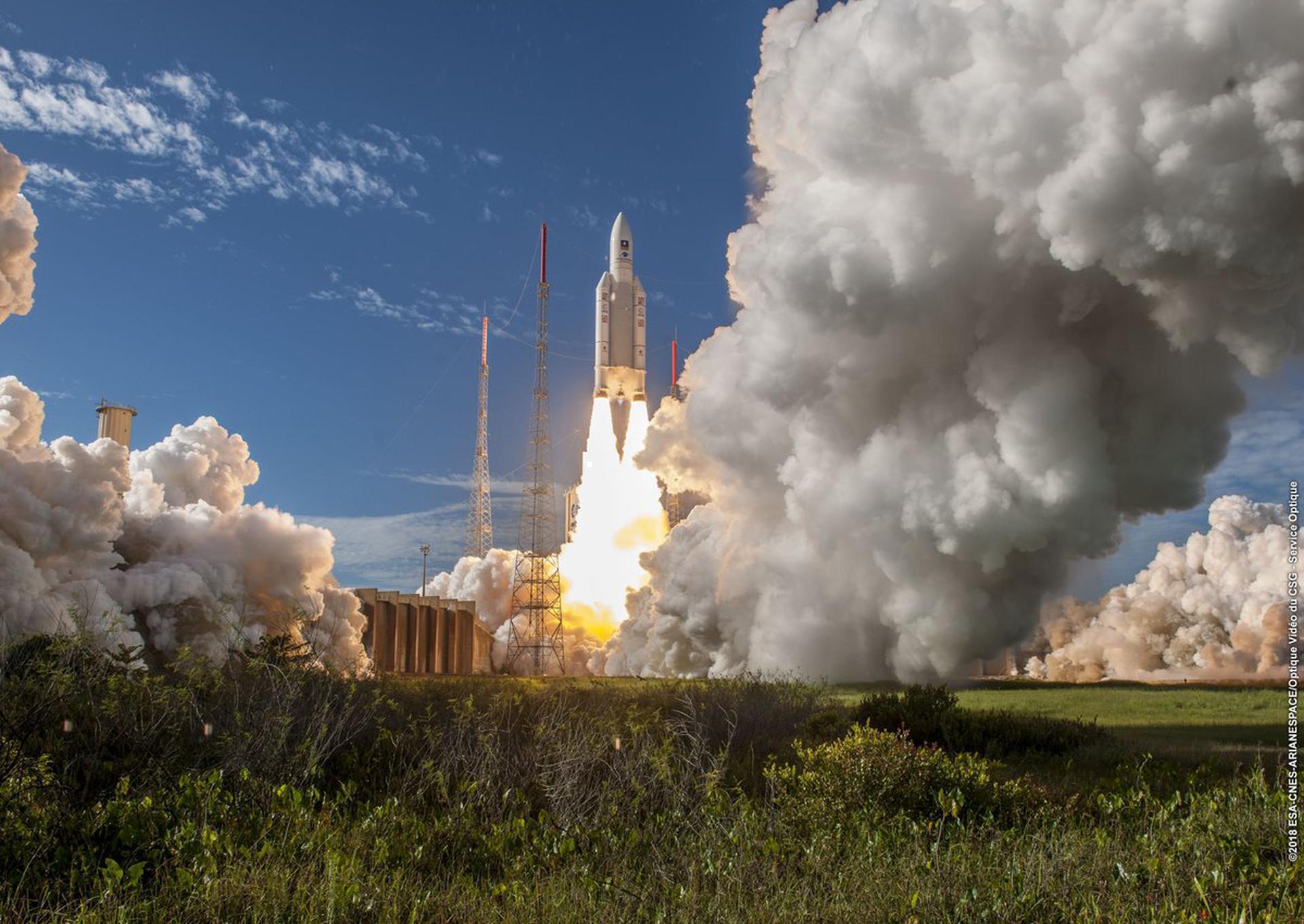
Ariane 5 ES
In-activeArianeGroup (AG)
March 9, 2008
Description
The Ariane 5 ES (Evolution Storable) has an estimated LEO launch capacity of 21,000 kg (46,000 lb). It includes all the performance improvements of Ariane 5 ECA core and boosters but replaces the ESC-A second stage with the restartable EPS used on Ariane 5 GS variants. It was used to launch the Automated Transfer Vehicle (ATV) into a 260 km circular low Earth orbit inclined at 51.6° and has been used 3 times to launch 4 Galileo navigation satellites at a time directly into their operational orbit. The Ariane 5 ES flew 8 times from 2008 to 2018 with no failures.
Specifications
-
Max Stage
2 -
Length
45.7 m -
Diameter
5.4 m -
Fairing Diameter
5.4 m -
Launch Mass
746.0 T -
Thrust
11400.0 kN -
Apogee (Sub-Orbital)
40000.0 km
Family
-
Name
Ariane 5 ES -
Family
― -
Variant
ES -
Alias
― -
Full Name
Ariane 5 ES
Payload Capacity
-
Launch Cost
― -
Low Earth Orbit
21000.0 kg -
Geostationary Transfer
Orbit
― -
Direct Geostationary
― -
Sun-Synchronous Capacity
―
ArianeGroup
Commercial
CEO: Martin Sion
AG 2015ArianeGroup (formerly Airbus Safran Launchers) is an aerospace company based in France. A joint venture between Airbus and Safran, the company was founded in 2015 and is headquartered in Issy-les-Moulineaux. It consists of three core arms: aerospace, defence and security.
Ariane 5 ES | Galileo L10 (FOC FM19-FM22)
ArianeGroup | FranceGuiana Space Centre, French Guiana
July 25, 2018, 11:25 a.m.
Status: Launch Successful
Mission:
The Galileo constellation is ESA's satellite navigation system and is expected to be completed by 2020. Galileo will provide Europe with an alternative to the American GPS and Russian GLONASS constellations, but will be interoperable with both systems.
Medium Earth Orbit #VA244Ariane 5 ES | Galileo L9 (FOC FM15-FM18)
ArianeGroup | FranceGuiana Space Centre, French Guiana
Dec. 12, 2017, 6:36 p.m.
Status: Launch Successful
Mission:
The Galileo constellation is ESA's satellite navigation system and is expected to be completed by 2020. Galileo will provide Europe with an alternative to the American GPS and Russian GLONASS constellations, but will be interoperable with both systems.
Medium Earth OrbitAriane 5 ES | Galileo L8 (FOC FM07 & FM12-FM14)
ArianeGroup | FranceGuiana Space Centre, French Guiana
Nov. 17, 2016, 1:06 p.m.
Status: Launch Successful
Mission:
The Galileo constellation is ESA's satellite navigation system and is expected to be completed by 2020. Galileo will provide Europe with an alternative to the American GPS and Russian GLONASS constellations, but will be interoperable with both systems.
Medium Earth OrbitAriane 5 ES | ATV-5 (Georges Lemaitre)
ArianeGroup | FranceGuiana Space Centre, French Guiana
July 29, 2014, 11:47 p.m.
Status: Launch Successful
Mission:
ATV-5 is the Automated Transfer Vehicle operated by the European Space Agency (ESA) to resupply the international space station (ISS) with propellant, water, air and dry cargo. After 15 days in orbit it docked to the ISS on 12th August 2014.
Low Earth OrbitAriane 5 ES | Albert Einstein ATV (ATV-004)
ArianeGroup | FranceGuiana Space Centre, French Guiana
June 5, 2013, 9:52 p.m.
Status: Launch Successful
Mission:
ATV-4 is the Automated Transfer Vehicle operated by the European Space Agency (ESA) to resupply the international space station (ISS) with propellant, water, air and dry cargo. After 10 days in orbit it docked to the ISS on 15th June 2013.
Low Earth OrbitAriane 5 ES | Edoardo Amaldi ATV (ATV-003)
ArianeGroup | FranceGuiana Space Centre, French Guiana
March 23, 2012, 4:34 a.m.
Status: Launch Successful
Mission:
ATV-3 is the Automated Transfer Vehicle operated by the European Space Agency (ESA) to resupply the international space station (ISS) with propellant, water, air and dry cargo. After 5 days in orbit it docked to the ISS on 23rd March 2012.
Low Earth OrbitAriane 5 ES | Johannes Kepler ATV (ATV-002)
ArianeGroup | FranceGuiana Space Centre, French Guiana
Feb. 16, 2011, 9:51 p.m.
Status: Launch Successful
Mission:
ATV-2 is the Automated Transfer Vehicle operated by the European Space Agency (ESA) to resupply the international space station (ISS) with propellant, water, air and dry cargo. After 8 days in orbit it docked to the ISS on 24th February 2011.
Low Earth OrbitAriane 5 ES | ATV-1 "Jules Verne"
ArianeGroup | FranceGuiana Space Centre, French Guiana
March 9, 2008, 4:03 a.m.
Status: Launch Successful
Mission:
ATV-1 is the Automated Transfer Vehicle operated by the European Space Agency (ESA) to resuplly the international space station (ISS) with propellant, water, air and dry cargo. After three weeks of orbit testing it rendezvoused with the ISS on 3rd April 2008.
Low Earth OrbitSoyuz 2.1a
Obzor-R No.1
43/4 (43R) - Plesetsk Cosmodrome, Russian FederationNote: Assignment of payloads to this launch is uncertain. The Russian Obzor-R satellite is a planned X-band radar earth observation satellite desi…
LVM-3 (GSLV Mk III)
BlueBird Block 2 #1
Satish Dhawan Space Centre Second Launch Pad - Satish Dhawan Space Centre, IndiaAST SpaceMobile’s Block 2 BlueBird satellites are designed to deliver up to 10 times the bandwidth capacity of the BlueBird Block 1 satellites, requi…
Long March 12A
Demo Flight
Long March 12A Pad - Jiuquan Satellite Launch Center, People's Republic of ChinaFirst test launch of CASC/SAST’s Long March 12A rocket, with a dummy payload. The rocket’s 1st stage attempted to land on a landing pad about 300 km …
HANBIT-Nano
Spaceward
HANBIT Pad - Alcântara Space Center, Federative Republic of BrazilMaiden orbital launch attempt for the South Korean start-up Innospace and its HANBIT-Nano small launch vehicle. Onboard this flight are five small sa…
H3-22
Michibiki 5 (QZS-5)
Yoshinobu Launch Complex LP-2 - Tanegashima Space Center, JapanQZSS (Quasi Zenith Satellite System) is a Japanese satellite navigation system operating from inclined, elliptical geosynchronous orbits to achieve o…

